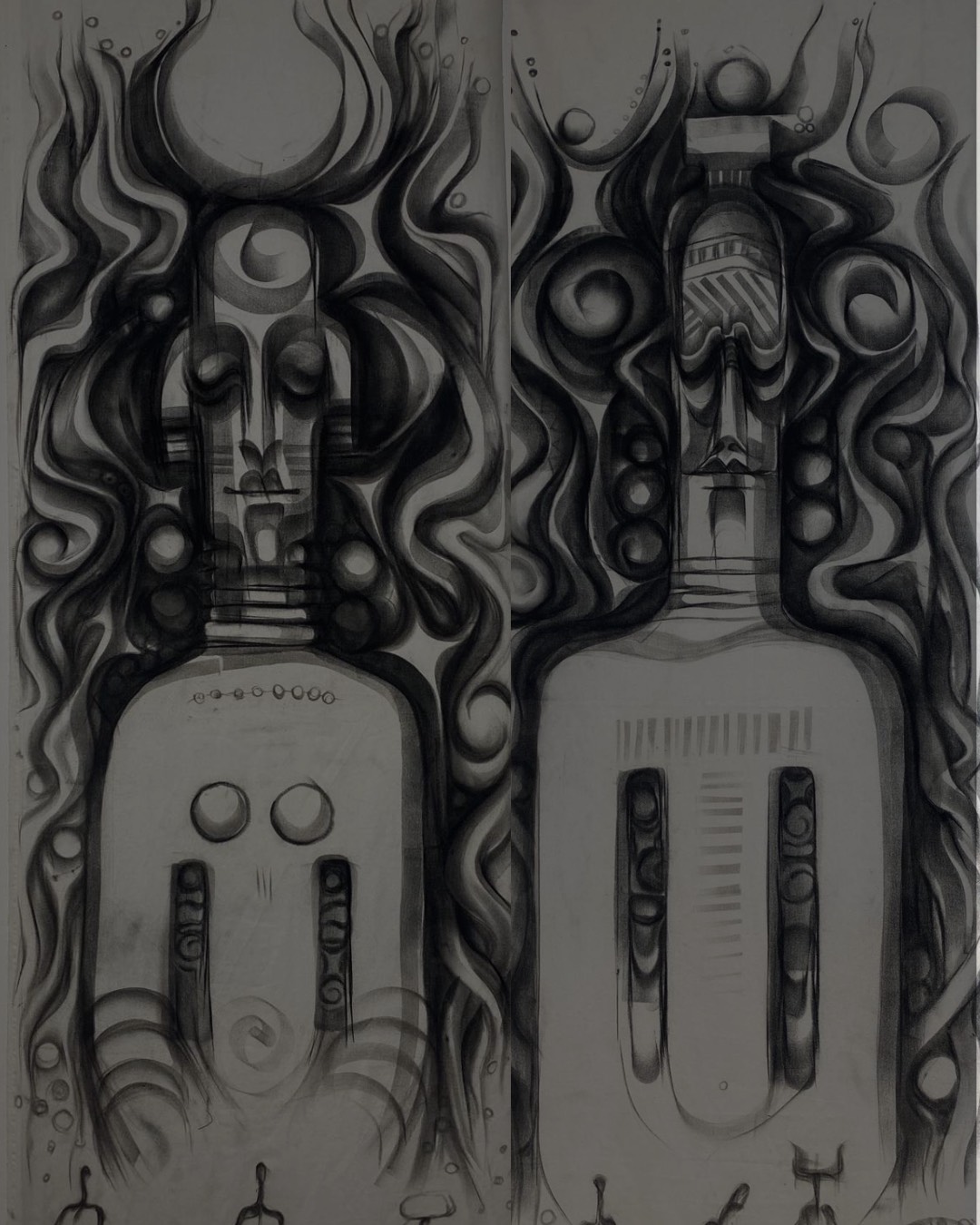In his compelling solo exhibition “Ife Kwulu, Ife a Kwudube Ya,” Chijioke Onuora masterfully intertwines the heritage of the Nsukka Art School with a contemporary reinterpretation of indigenous Igbo aesthetics. Drawing on the revival of uli art pioneered by the historic Nsukka Group, the exhibition explores themes of duality and collective identity, reflecting both the timeless traditions of pre-colonial art and the artist’s formative influences. This dynamic dialogue between past and present invites viewers to experience a vibrant continuum where cultural legacy meets modern artistic expression.
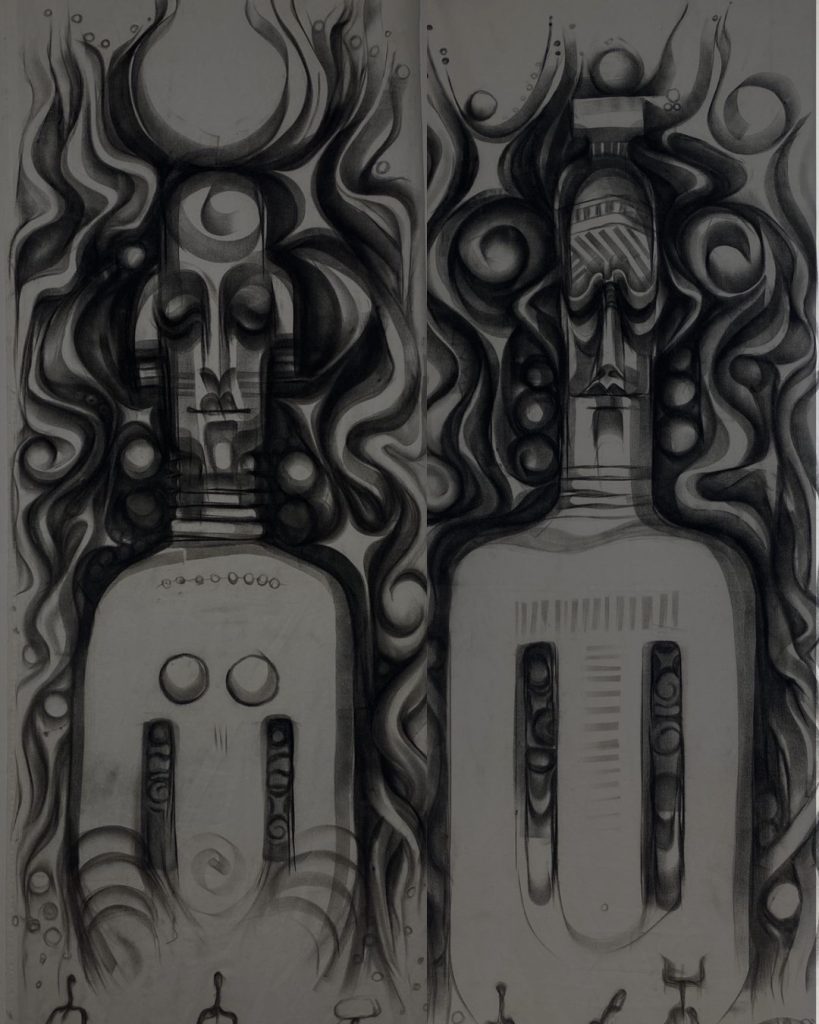
The Nsukka Group and Its Legacy
The Nsukka Group involved a group of artists whose works were associated with the use of uli, or uli paintings. Led by Uche Okeke, the pioneer members of this group included Tayo Adenaike, Olu Oguibe, Chike Aniakor, El Anatsui, Ada Udechukwu, and Obiora Udechuku, all of whom had a profound impact on Chijioke Onuora’s career as a young artist during his undergraduate journey. Another artist affiliated with the Nsukka Group was Seth Anku, Chijioke’s lecturer whom he lived with and learnt from for a period of time.
The Nsukka Group was born out of the need to identify, preserve, and modernise art forms indigenous to the South-Eastern region in Nigeria. The prominent category focused on was the use of uli – reviving its practice and incorporating its original designs into contemporary art. The Poetics of the Line: Seven Artists of the Nsukka Group, was an exhibition held in 1997 at the National Museum of African Art at the Smithsonian Institute. It pledged a testament to the artistic nature of artists bred and affiliated with the art school at the University of Nigeria, Nsukka, during that time. This timely exhibition showed the revival of the art scene in the Eastern region, which was visibly recovering from the effects of the civil war.
The influence of the Nsukka Group has reverberated across generations until today. Over time, the University of Nigeria and its host town have come to be associated with uli. The Nsukka Group movement also spurred the rise of the Ona artists at the Obafemi Awolowo University in Ibadan, who focused mostly on Yoruba-inspired art.
Now, the Nsukka Art School is used to identify artists with education from the University of Nigeria, Nsukka. Recent exhibitions associated with the art movement include the three-part exhibition series: The New Nsukka School, which featured solo exhibitions from artists in 2021, who attended and currently attend the university.
Chijioke Onuora’s past exhibitions depict the impact of being mentored by the pioneers of The Nsukka Group. Being educated at the university, and having risen through the ranks to become a Professor of Sculpture at the Faculty of Arts, his artistic prowess has been experimented in sculpture, painting, and woodwork using different media.
The Artist: Professor Chijioke Onuora
Professor Chijioke Onuora’s artistic roots date back to his family. In an interview, he revealed that his great-grandmother was an uli artist. His gradual progression from creating illustrations in primary school to exploring other art forms as he gained formal education helped expand his forte.
When he started out, he drew inspiration from Rembrandt and Michelangelo, moved on to Picasso, and finally tethered his anchor to home-grown artists like Obiora Udechukwu and El Anatsui during his time at the university. There, he was introduced to the intriguing world of uli and became instantly captivated, incorporating it into his works from then on. Seth Anku’s mentorship cemented his formative years as an artist, as he was exposed to a myriad of means to ease his artistic process through innovative techniques and unconventional methods.
If Chijioke’s introduction to uli piqued his curiosity to learn more about the indigenous art forms sequestered in the Eastern region of Nigeria at the time, his undergraduate project answered some of the questions he had.
The project – Art Objects of Adazi-Ani Shrines- granted him direct access to the sacred art objects in shrines used in traditional worship during pre-colonial times in Igbo land. After this encounter, his works, which were primarily based on naturalistic drawings of the female form, morphed due to the heavy influence of uli, a recurring memento on the walls of the shrine and his family’s private compound.
His unique position as a practicing Christian and an artist with a great affinity for Igbo traditional art places him at a crossroad. However, he is firm and yet gentle with his approach. “I am attracted to the traditional art of my people, although I do not adhere to the traditional religious belief system. However, it is essential to note that the artistic forms I create reflect the distinctive art style of my people. For example, if I decide to paint The Last Supper today, you may not see a depiction of male blondes with blue eyes; instead, you would likely see images that were derived from the local sculpture forms.”
The Exhibition
During Chijioke’s research for his undergraduate project, he struck gold – ihe di ibuo ibuo, a recurring theme that would present itself in all his art pieces moving forward. Ihe di ibuo ibuo is a phrase which loosely translates to ‘things come in pairs’. In Igbo cosmology, it is expressed intimately in the relationship between Udo and Ogwugwu, the male and female deities. In his work, this pairing symbolizes the relationship between the Nigerian political class and the masses. His exhibitions all bear semblance to this train of thought and represent it in unique ways.
Chijioke Onuora: Akala Unyi was an exhibition held in 2014 of forty-eight drawings made on paper, with charcoal, graphite, and chalk. The varied pieces had connotations of uli and served to create awareness about societal issues. His earliest representation of the Igbo adage ife kwulu, ife a kwudube ya (a thing that stands has something else that stands besides it) in art can be traced back to his art piece, Ibo N’ibo Kwulu, a stylised portrait of a couple, publicly exhibited in 2014.
In consonance with the preservation of Igbo culture, he presented two batik pieces at the [Re:] Entangled Traditions exhibitions project in 2020. Ezeana Obidigbo was modeled after the portrait of Ezeana Obidigbo of Neni, with prominent ichi scarifications. Nze na Nwunye Ya was inspired by the image of male and female mud relief sculptures, taken by Northcote W. Thomas.
His debut solo exhibition, Mark Making, was held at the Centre for Contemporary Art, Lagos, in 2022. Several years of studio practice were on display, as the artworks which depicted the ritual art of mark making were etched onto different art media in batik, sculpture, drawing, and painting. His latest solo exhibition Ife Kwulu, Ife a Kwudube Ya, guest curated by Ugonna Ibekwe, focuses on the duality of existence. It marks a milestone in his artistic journey with his transition to using charcoal and dye on fabric and the magical blend of modern art with concepts rooted in Igbo tradition. In carrying on the Nsukka School tradition, Onuora’s work embodies and reinterprets this legacy, drawing from the techniques and themes of his mentors while forging his own distinct path.
The Pieces and Their Cultural Relevance
All the pieces presented in this exhibition focused on the duality of existence, small pieces being part of a greater whole, and the hierarchy of leadership in Igbo communities.

Umuada I, 2023
Charcoal on paper
23×35 inches
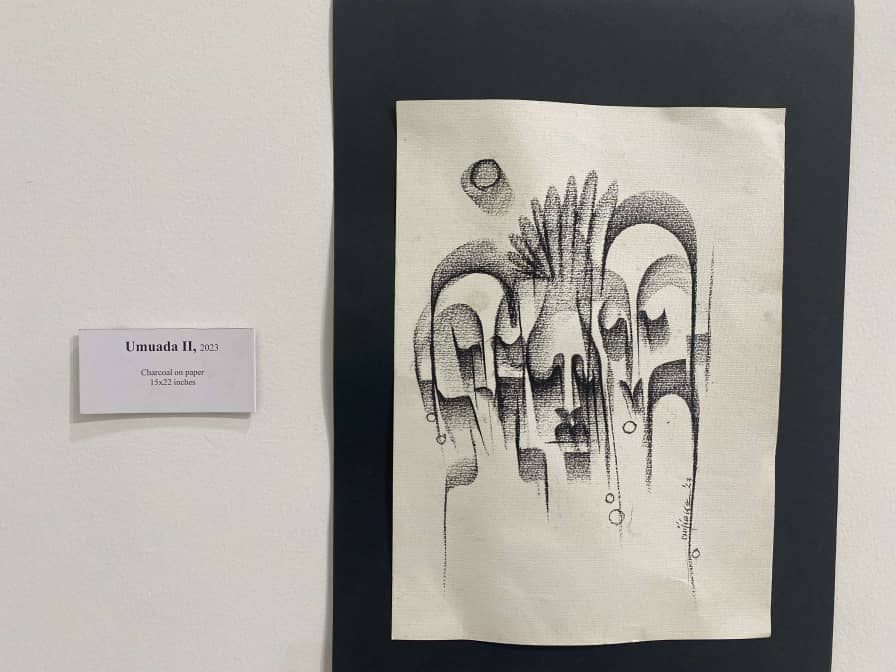
Umuada II, 2023
Charcoal on paper
15×22 inches
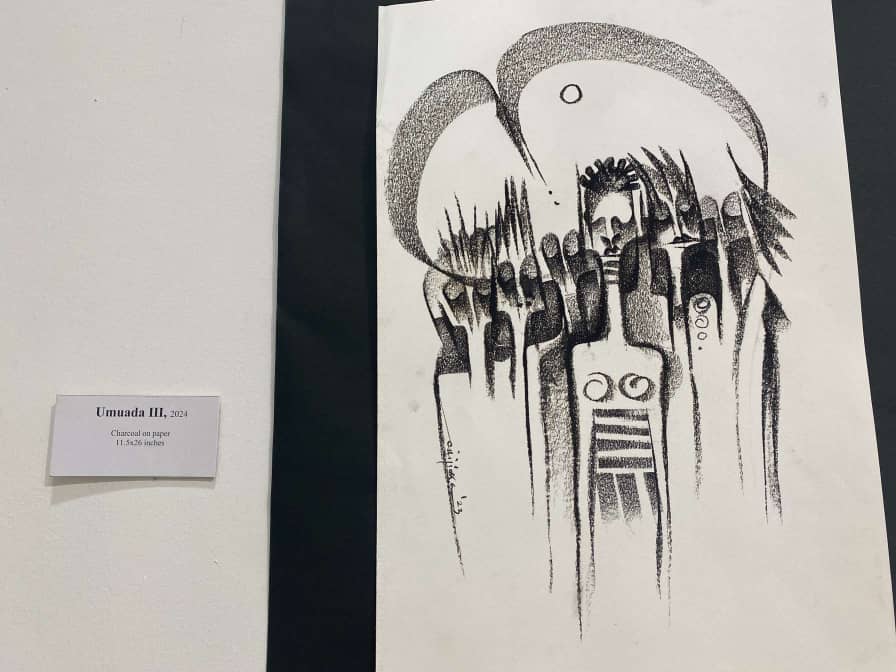
Umuada III, 2024
Charcoal on paper
11.5×26 inches
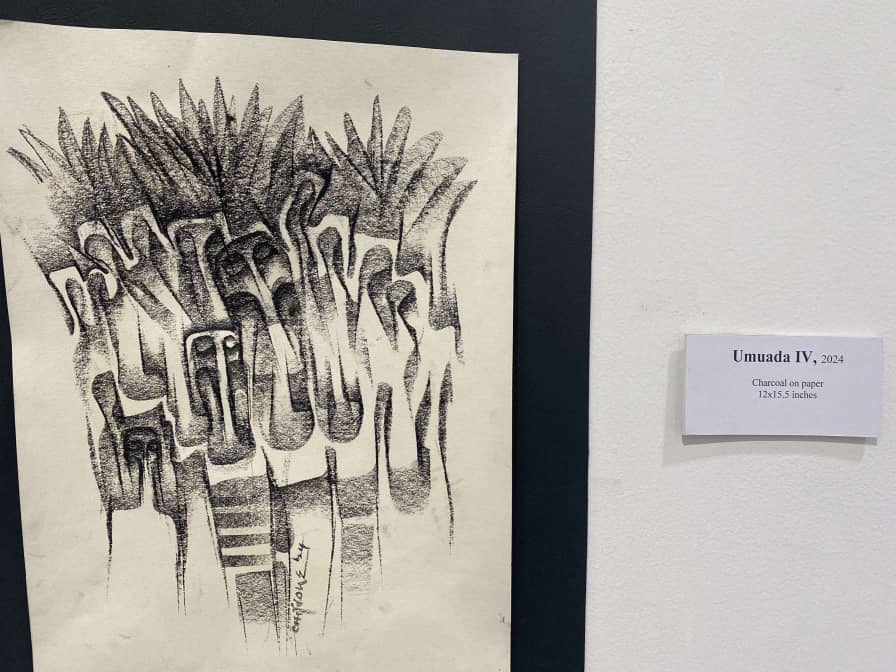
Umuada IV, 2024
Charcoal on paper
12×15.5 inches
“Among the Igbo, you dare not underestimate the powers of the Umuada. They enjoy dual citizenship both in their husband’s house and their father’s house. Break their rules at your own peril.”
On his Instagram page, Onuora presented the Umuada as a force to be reckoned with.
“In line with my current studio efforts on leadership, this drawing beams a searchlight on the place of the Umuada on the leadership structure of the Igbo people.”
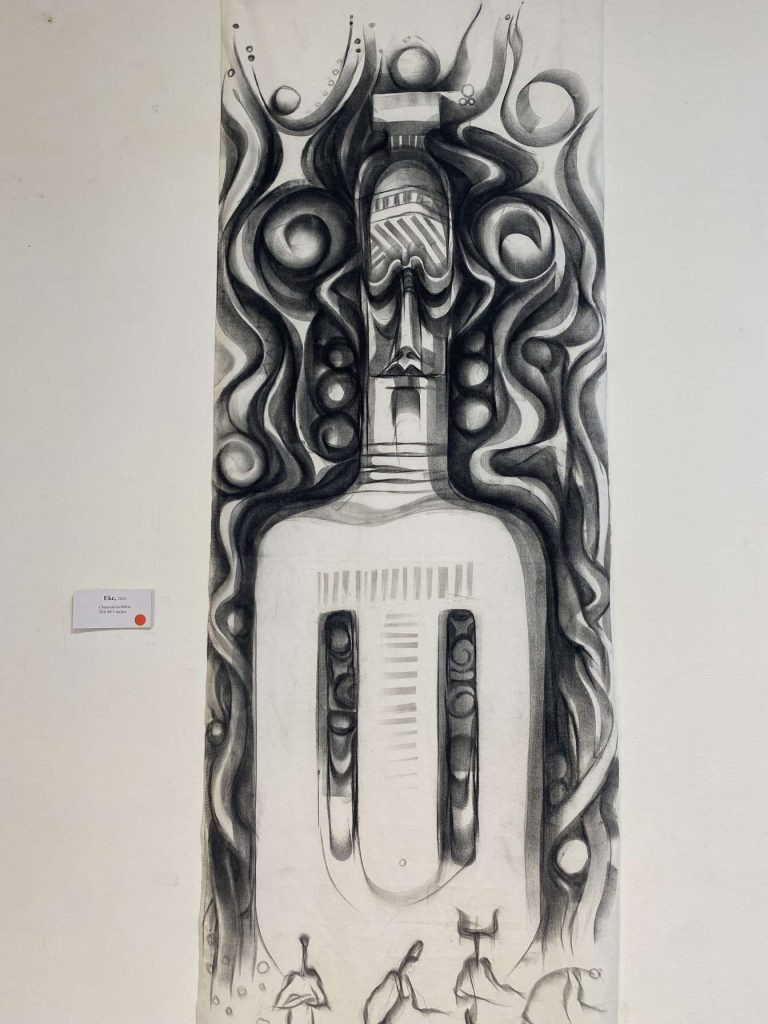
Eke, 2024
Charcoal on paper
28×8.5 inches
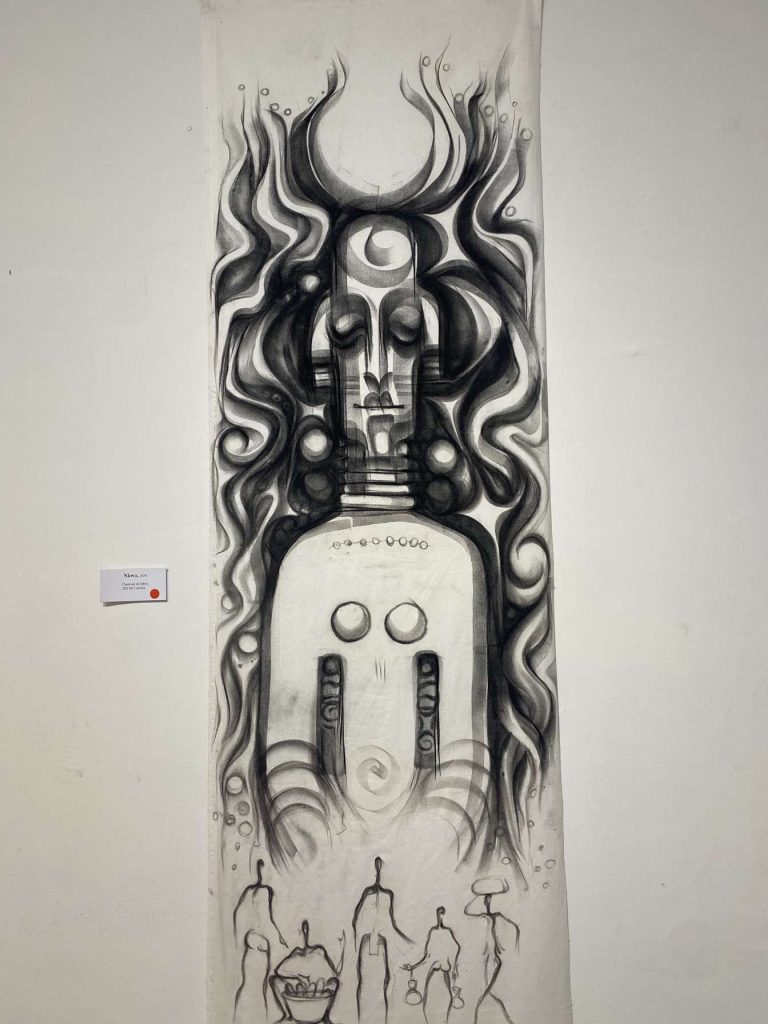
Nkwo, 2024
Charcoal on paper
28 × 8.5 inches
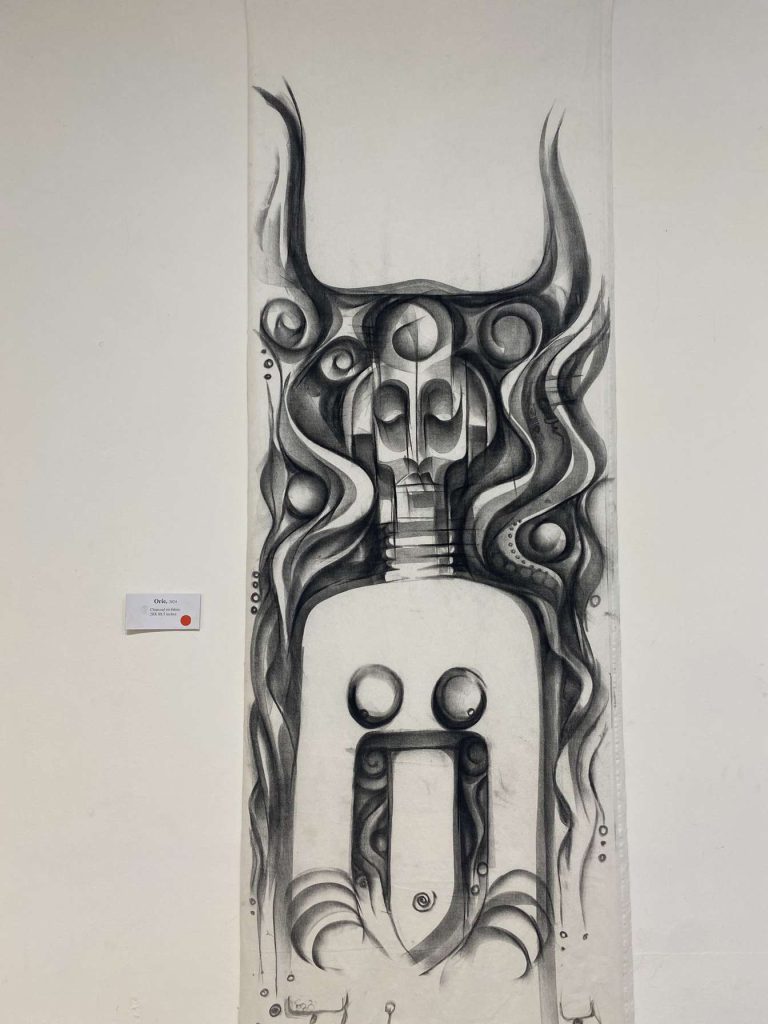
Orie, 2024
Charcoal on paper
28 × 8.5 inches
Eke, Nkwo, and Orie are weekdays of the Igbo calendar. Onuora presents these days as a trilogy of deities overseeing the activities assigned to those days, and the mortals who carry them out.

Ikoro na umuokorobia, 2023
Charcoal on paper
22 × 15 inches
In pre-colonial Igbo history, the Ikoro was noted to be a village’s official way of summoning its dwellers to the village square. In this piece, Ikoro na umuokorobia, the Ikoro summons the young men in preparation for war, and they spring into action with spears in hand.
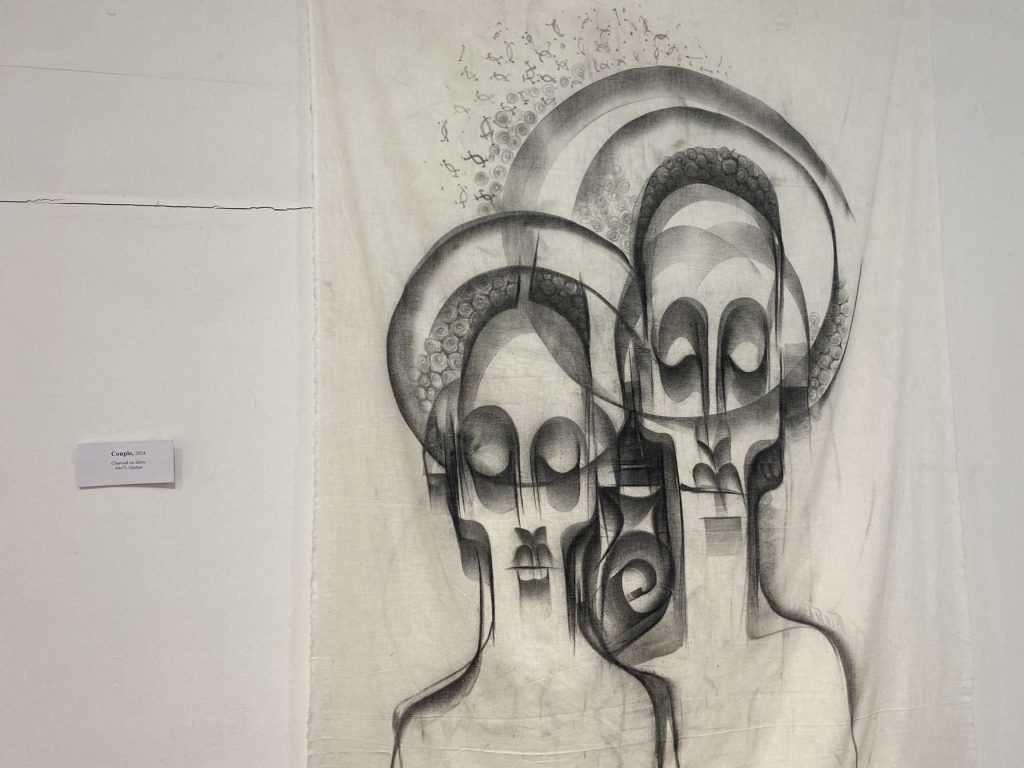
Couple, 2024
Charcoal on paper
44 × 71.5 inches

Family, 2023
Charcoal on paper
15×22 inches
Couple and Family present a modern expression of Igbo families, as opposed to polygamy associated with traditional Igbo family settings.
Chijioke Onuora’s artistic oeuvre takes art enthusiasts and researchers interested in pre-colonial Igbo history and Igbo cosmology on an exciting journey. His pieces have extensively portrayed prominent and overlooked concepts in Igbo culture and spirituality.
The exhibition expresses how art can connect the past to a fresh, modern perspective. Onuora’s body of work honors the long-standing traditions of the Nsukka School while telling a contemporary story filled with cultural pride. His art, rich in symbolic nuance and skill, leaves an enduring impact on the community — serving as a catalyst for a renewed look at indigenous heritage.



